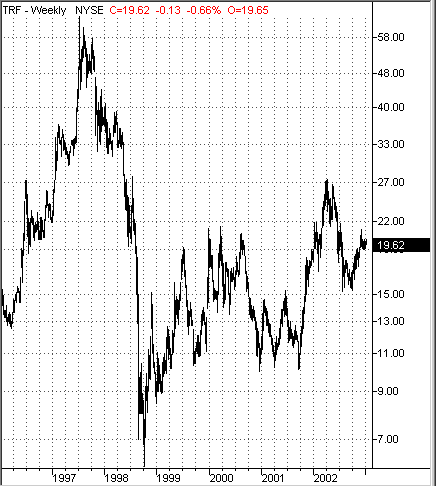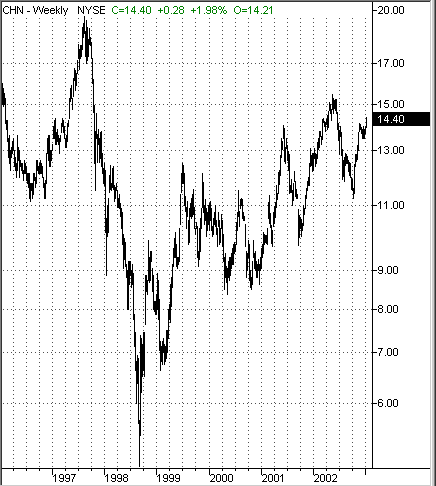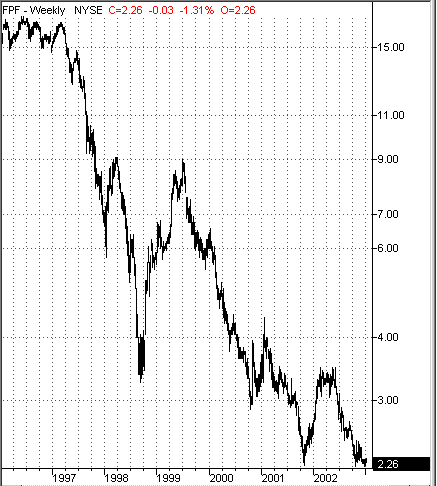
HOT TOPICS LIST
- Strategies
- Stocks
- Buy
- Investing
- Brokers
- Psychology
- Interviews
- Accumulate
- Sell
- Hold
- Spotlight
- Websites
- Candlestick Corner
- Gold & Metals
- Options Trading
LIST OF TOPICS
MARKET COMMENTARY
Buy And Hold Bonanzas
01/07/03 03:16:50 PM PSTby David Penn
Buy and hold investing still works, but you've got to pick the right partners.
| One of the most compelling arguments for buy-and-hold investing was put forward by money manager Marc Faber in an often-repeated, yet almost throwaway remark he is fond of making in interviews and essays:
If you look back at the last 30 years, an investor could have made a lot of money by being very lazy. He could have bought oil at $1.30 a barrel, gold at $35 an ounce, and silver at $1.80 an ounce, and then gone on a holiday and come back in 1980 and sold gold at $850 an ounce and oil close to $50 and silver close to $50 an ounce.
Not bad, eh? It gets better.
Then he could have shifted all his money into Japanese stocks and gone again on a holiday until 1990 and sold out his Japanese shares with a seven times gain, and then bought into the S&P or the Nasdaq, and then gone again on a holiday until March 2000.
Skeptics may pout that it would have been impossible for traders and investors — particularly retail, relatively uninformed investors — to know in 1970 there would be a sizable bull market in gold. How could anyone have believed the Japanese stock market would take off in 1980? And as for the Nasdaq, fuhgettaboutit. Who in 1990, with the Nasdaq at 460, could have anticipated Nasdaq 5,000? But these skeptics would miss the point. Say you weren't sharp enough to buy gold in 1970 at $35 an ounce and, instead, waited until 1975. Or perhaps you were too sharp for your own good and bought gold in 1970, but sold in 1976. In either case, the returns would have been outstanding. From 1970 to 1976, gold appreciated over 200% (1976 was a low point in gold's bull market in the 1970s, by the way). From 1975 to 1979, gold appreciated over 340%. The point here is that in a secular bull market — just as the one in stocks proved — there are numerous opportunities to get on board. But the more important point is this. It is far more important to be in the right asset class than to be in the right subgroup of that asset class. This point is a major theme in Mark Boucher's The Hedge Fund Edge, and is used to great effect in his discussion on bonds as an asset class. In other words, when it is time to invest in stocks, it is time to invest in stocks. Sure, a little extra time might allow a disciplined investor or trader the opportunity to invest in, for example, the Nasdaq in the 1990s as opposed to the Standard & Poor's 500 (or certainly the Dow Jones industrials). But the more important factor for the investor is to determine which asset classes are going to benefit from the prevailing economic and political climate. This is especially important now in 2003 as investors — indeed, money itself — search about for new leadership. In an essay titled "Timing Your Leap Into The Unpopular," Faber explains that there is a sort of "paralysis" that grips investors when an old investing theme — such as US growth stocks — dies and a new investing theme has yet to be born. Cherishing the recent memories of gains made from the old investing theme, many investors can't help but long for the signs that they might, once again, roar to the front of the pack and lead the whole team higher. One small example of this is the way that many of the technology and telecommunications companies that had been decimated by the Nasdaq collapse in 2000 were among the leaders in the powerful bear market rally of October 2002. Many investors were lured back into these shares on news that $5 tech stocks were up 100% (many stocks that were less than $1 went up by even more). However, these same investors failed to realize these stocks were down by as much as 60% or 70% from their all-time highs. One example should suffice: I2 Technologies (ITWO) fetched a price of about $104 per share in March 2000. Two years later, I2 Technologies could be purchased for $5.90 a share, a decline of over 90%. By October 2002, I2 was down even further, marking a low of $0.41 per share. Yet less than two months later, analysts could shout that I2 Technologies was up more than 350% "from the lows." Never mind that 350% increase had brought I2 Technologies up to a mere $2 per share, down more than 98% from its all-time high.
LEAPING INTO THE UNKNOWABLE
It is imperative that investors shed their loyalties when old investment themes die. When it's over, it's over, and no amount of denial will make the old leaders capable of driving the next bull market. At the same time, for those investors truly interested in ferreting out the most rewarding places in which to invest their savings, this period between investment themes, this period of "paralysis," is crucial, as Faber notes:
I would argue that from a timing point of view, it is precisely when there are no obvious major investment themes in the minds of investors that the opportunities for them are most appealing, because in such an environment of general uncertainty the next major investment themes are born. . . I would therefore like to emphasize that, in terms both of the timing and the magnitude of the forthcoming move, the opportunity is greatest for capital gains when there is an absence of major themes in the minds of investors. I have stressed "in the minds of investors" because, in the real world, there is never a lack of major themes. It is just that the investment community does not perceive that a new major trend is already in the process of fermenting and shaping up.
That said, what are the market-oriented, "new major trends" that are "already in the process of fermenting and shaping up"? As a guide in this search, let's pretend we successfully bought oil and gold in 1970, sold it at a profit and bought Japanese stocks in 1980, sold them at a profit and bought US growth stocks in 1990, and have just sold those a few short years ago. It is 2003, just a couple of years into the decade. Where might we find a theme powerful enough to take our investments profitably over the next seven to 10 years?
Figure 1: Russia has been one of the top contrarian plays for the past three years, as this closed-end fund, TRF, suggests.
One way to narrow down the places where one might look for interesting investment opportunities is to examine long-term historical charts from various countries — especially those that are infrequently commented on, or have a reputation for being difficult places to invest. Sometimes these reputations can outlive their accuracy, blinding uninformed investors to realities that may have changed dramatically. Perhaps the most obvious case of this is investment in Russia and the formerly Communist nations of Eastern Europe. The Russia Moscow Times index of equities, for example, shows Russian stocks bottoming in 1998 (around the time of the Russian debt default). Bumping around 500 for a few years, this index began to rise sharply in the last quarter of 1999, was relatively flat during 2000, and again exploded to the upside in 2001 and into 2002, where it peaked above 5,000 by mid-year. This represents a gain of about 900% in about four years. How could an average investor have participated in the bull market in Russian stocks? One way would have been through closed-end funds like the Templeton Russia Fund (TRF), which was priced between $79 in 1998 and reached a high of $28 early in 2002 for a gain of anywhere from 200300%. What is telling about this period in contemporary Russian history is that, particularly in the West, media commentary on Russia was focused on the trials and tribulations of Boris Yeltsin, who was Russia's president until December 31, 1999, or on the war with the would-be breakaway republic of Chechnya, which began in the late 1990s.
SPANNING THE GLOBESo are there other "Russias" out there — regions and nations with strong growth potential in their economies, yet unable thus far to attract the sort of foreign investment and domestic savings necessary to create the capital gains of a major secular bull market? Another market that has shown strength since the spring of 2000 is the stock market of Slovakia, one of the two republics founded in the wake of the separation of Czechoslovakia (the other is the Czech Republic). Slovakian stocks, as measured by the SAX (Slovensky Akciovy index), appreciated steadily through 2000 and 2001, up some 60% from their lows in 2000. Strict exposure to Slovakian equities is not as easy as getting exposure to Russian equities — and even less so now that one of the leading closed-end funds that invests in Eastern Europe, the Central and Eastern European fund (CEE), has increased its Russian holdings. But those looking to tap into growth in the former Communist bloc could do worse than to consider funds like CEE.
Figure 2: Access to Chinese equities is difficult, but less so through funds like the China Fund, shown here.
Asia is another area where a great deal of "contrarian" investment interest — and not a few contrarian investment dollars — has flowed. But whereas in the past investors piled money into countries like Japan, South Korea, and Taiwan, the new Asian investor is more looking to places like Thailand and China — and even the Philippines and Sri Lanka. At this point, China's story is increasingly well-known, even if the means to access China's incredible growth potential remain limited. Chinese equities (as measured by the Shanghai Composite index) exploded in 1999, doubling in price in just two years before correcting sharply in 2001. In early 2003, it appears as if Chinese stocks have bottomed, insofar as they have spent most of the year churning in a fairly wide range. A glance at one of the more commonly traded closed-end funds, the China Fund (CHN), reflects the bullishness of Chinese equities over the period. From a 1998 low of 4.94, the China Fund rose to 15.46 by the spring of 2002, a gain of over 200% in four years. Two other interesting Asia plays may be the Philippines and Thailand, where stocks have been in a bear market since peaking out in early 1997. While the Manila composite index of the Philippines is still trending downward in 2002, the Bangkok SET index of Thailand actually appears to have made a bottom late in 2001 and was up some 50% by the summer of 2002. Closed-end fund offerings for Thailand and the Philippines are limited, but they do exist in the form of the Thai Capital Fund (THCF) and the Philippines Fund (FPF).
Figure 3: Still searching for a bottom, Philippine shares may benefit if neighbors in Asia continue to advance.
The debt default and depression in Argentina make the land of the gaucho another place where contrarian investors looking for worldwide value have been keeping a close watch. There's no denying the economic problems in Argentina — or in its neighbor to the north, Brazil, which, while troubled, is not in nearly such bad shape as Argentina. But Argentina is one of the larger economies in South America, and has an educated and growing population — to say nothing of its many worthwhile natural resources, especially in agriculture. In much the same way the bust in Asia eventually provided opportunities for investors to re-enter the market years afterward, so do some believe Argentina (and even other South American countries such as Peru) will similarly rebound economically and provide great opportunities for growth and development.
David Penn may be reached at DPenn@Traders.com.
SUGGESTED READINGBoucher, Mark [1999]. The Hedge Fund Edge, John Wiley & Sons.Faber, Marc [2002]. "The Next Big Thing," interview with Jim Puplava, Financial Sense Online (FinancialSense.com): November. _____ [2002]. "Timing Your Leap To The Unpopular," GloomBoomDoom.com: September. Charts courtesy of TradeStation (TradeStation Technologies)
|
Technical Writer for Technical Analysis of STOCKS & COMMODITIES magazine, Working-Money.com, and Traders.com Advantage.
| Title: | Traders.com Technical Writer |
| Company: | Technical Analysis, Inc. |
| Address: | 4757 California Avenue SW |
| Seattle, WA 98116 | |
| Phone # for sales: | 206 938 0570 |
| Fax: | 206 938 1307 |
| Website: | www.traders.com |
| E-mail address: | DPenn@traders.com |
Traders' Resource Links | |
| Charting the Stock Market: The Wyckoff Method -- Books | |
| Working-Money.com -- Online Trading Services | |
| Traders.com Advantage -- Online Trading Services | |
| Technical Analysis of Stocks & Commodities -- Publications and Newsletters | |
| Working Money, at Working-Money.com -- Publications and Newsletters | |
| Traders.com Advantage -- Publications and Newsletters | |
| Professional Traders Starter Kit -- Software | |
PRINT THIS ARTICLE

|

Request Information From Our Sponsors
- StockCharts.com, Inc.
- Candle Patterns
- Candlestick Charting Explained
- Intermarket Technical Analysis
- John Murphy on Chart Analysis
- John Murphy's Chart Pattern Recognition
- John Murphy's Market Message
- MurphyExplainsMarketAnalysis-Intermarket Analysis
- MurphyExplainsMarketAnalysis-Visual Analysis
- StockCharts.com
- Technical Analysis of the Financial Markets
- The Visual Investor
- VectorVest, Inc.
- Executive Premier Workshop
- One-Day Options Course
- OptionsPro
- Retirement Income Workshop
- Sure-Fire Trading Systems (VectorVest, Inc.)
- Trading as a Business Workshop
- VectorVest 7 EOD
- VectorVest 7 RealTime/IntraDay
- VectorVest AutoTester
- VectorVest Educational Services
- VectorVest OnLine
- VectorVest Options Analyzer
- VectorVest ProGraphics v6.0
- VectorVest ProTrader 7
- VectorVest RealTime Derby Tool
- VectorVest Simulator
- VectorVest Variator
- VectorVest Watchdog



